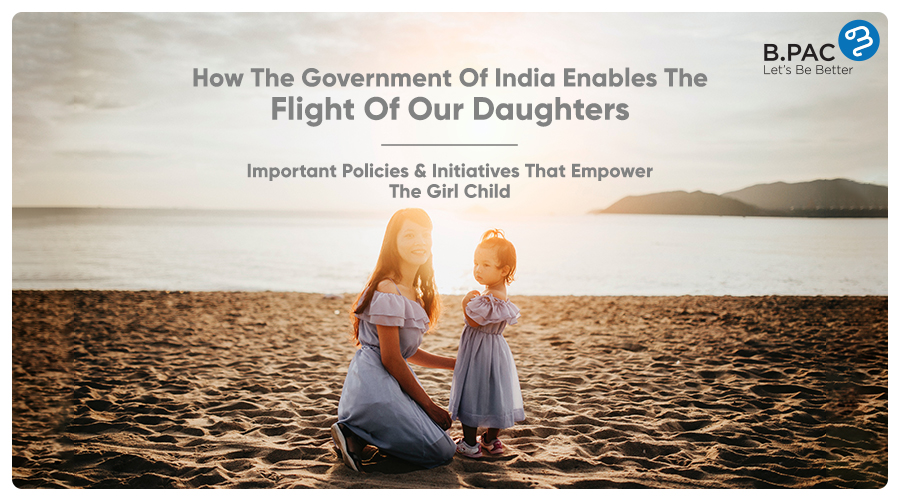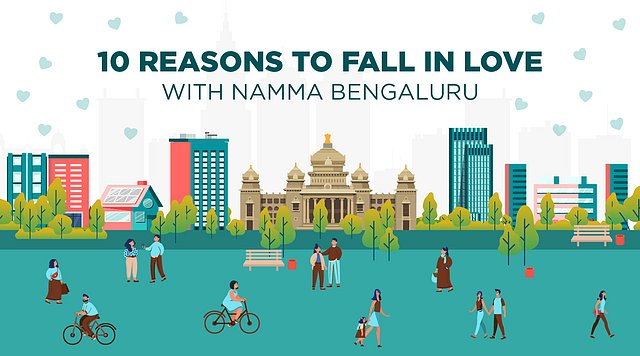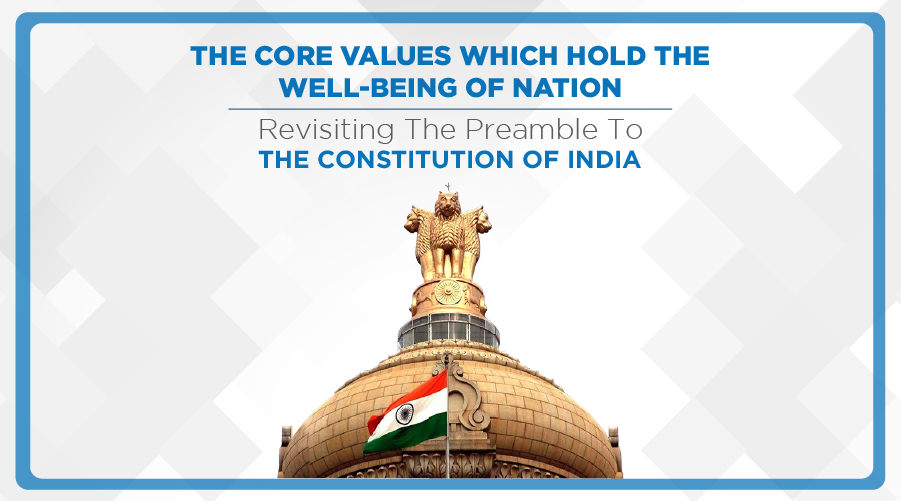Important Policies & Initiatives That Empower The Girl Child
“A daughter is a miracle that never ceases to be miraculous, loving and caring, and truly amazing.” – Deanna Beisse
Affectionate, caring, nurturing are some words that come to mind when one thinks of the word ‘daughter’. A daughter binds a family together.
To appreciate everything a daughter does for her family, Daughters’ Day is celebrated in the last week of September. This day is significant because it conveys that daughters are a blessing for the parents and are worthy of being celebrated. This day aims to shatter all the notions created by patriarchy about daughters.
Background of Daughters’ Day:
For many years, the world believed that daughters weren’t significant in a family. Patriarchy reigned strong in many countries, affecting a woman’s status in her family comprar kamagra paypal and society. Over time, as many people realised the importance of a daughter and shifted their focus to empowering her, the governments of many countries decided to bring into effect a day that cherishes and encourages daughters. The result was ‘Daughters’ Day’, a day to convey a strong message that a daughter is important. The day is also celebrated to create awareness around the discrimination of a girl child.
At the international level, different countries worldwide celebrate Daughters’ Day on different days of September. While promoting gender equality is one of the aims, the main focus is to celebrate the blessings and joy that a daughter brings into the lives of her parents, grandparents and other relatives.
Daughters’ Day in India:
Daughters’ Day in India was first celebrated to highlight the importance of a girl child. It also aimed to do away with the stigmas surrounding gender by focussing and emphasising equal opportunities to girls, be it in education, work or life.
This day aims to highlight issues like dowry, which is still prevalent despite numerous laws against it. This day also focuses on matters of high importance like female foeticide and infanticide, which continue to be rampant, despite multiple measures taken to create awareness.
India before policies:
The Towards Equality Report (Part 1 & Part 2), by the Committee on Status of Women in India (1974-1975) highlighted the discriminatory socio-cultural practices which paved the way for numerous women’s movements and upliftment in the country:
- Literacy rate: Literacy rate indicates the literate portion of the adult population over 15 years of age. 1971 showed a dismal level of 18.7% literacy rate among the females, indicating illiteracy and semi-illiteracy amongst women, with only an insignificant fraction being educated.
- Sex ratio: Sex ratio helps to understand the population of women per thousand men. Indian, in 1971 witnessed a drastic decline in sex ratio, and there were 930 females per 1000 males in the country, as against 972 females per 1000 males, in 1901. A significant cause of the decrease in the female population is due to selective sex determination during pregnancy, leading to foeticide and infanticide.
The numerous statistics collected over time emphasised the need to have more policies encouraging girls and women, resulting in the government introducing many policies to help the girl child get better access to education and save for her future.
Policies to help the girl child:
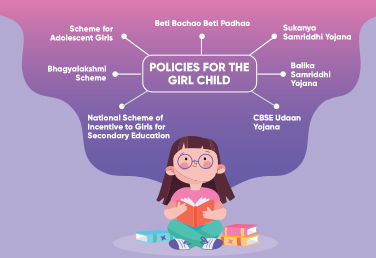
The government came up with many development programs aimed at the growth of women. Many schemes were introduced to uplift women and girls in urban and rural areas to create awareness.
Here are some schemes formulated by the state and the central government for the welfare and development of the girl child:
Beti Bachao Beti Padhao is a national initiative launched in 2015 to address the declining Child Sex Ratio (the number of females per thousand males in the age group 0-6 years). The scheme also aims to enhance women empowerment by eliminating gender-based inequalities.
The objective of this scheme is to prevent gender bias and sex-selective elimination. The scheme aims to ensure the survival and protection of the girl child, along with her education and welfare.
Features of Beti Bachao Beti Padhao:
- Spreading awareness about child sex ratio and working towards its improvement through debates and discourses.
- Motivating the communities to work towards the development of the birth and growth of a girl child.
- Safeguarding the girl child by stopping activities like foeticide and female infanticide.
- Ensuring access to education for every girl child.
- Prevent child marriage and ensure the safety of the girl child against harassment and violence.
Eligibility for the scheme:
- A family with a girl child below ten years of age.
- The girl should be an Indian resident.
- A Sukanya Samriddhi account has to be created in the name of the girl child.
Sukanya Samriddhi Yojana (girl child prosperity scheme) is a scheme that encourages parents to create a fund for the education and marriage expenses of their girl child. This initiative was launched in 2015, along with the Beti Bachao Beti Padhao campaign.
This scheme currently has an interest rate of 7.6%, and over 25 banks assist in opening a Sukanya Samriddhi Account.
Features of Sukanya Samriddhi Yojana:
- The initial deposit amount is Rs. 250, after which any amount in multiples of 100 can be deposited.
- The account can be opened anytime between the birth of the girl child until she attains ten years of age.
- This scheme allows the opening of only one account per girl child.
- The Sukanya Samriddhi Account can be opened in a post office or authorised banks.
- The account reaches maturity after 21 years from the time of opening it.
- The maximum amount that the account can hold is Rs. 1,50,000.
Balika Samriddhi Yojana was launched in 1997 to improve the status of the girl child (from families below the poverty line) and bring about a positive transformation in the attitude of the family and the communities.
The scheme aims to protect and improve the enrolment of girls in schools. It aims to assist in bringing up the girl child till she attains the legal age to be married. This scheme also aims to encourage girls to take up income-generating activities for their welfare.
Features of Balika Samriddhi Yojana:
- Eligible children under the scheme are present with Rs. 500 as a post-birth grant amount.
- Girl children born after 15 August 1997 and registered under the scheme are eligible for Class I to X scholarships.
- The scheme applies to rural (families identified below the poverty line according to the criteria specified under Swarnajayanti Gram Swarozgar Yojana) and urban areas (families living in urban slums and families working as rag-pickers, vegetable and fruit sellers, etc.).
- The benefits of this scheme apply to a maximum of two girl children per family, irrespective of the number of children in the family.
CBSE Udaan Yojana is an initiative by CBSE to provide free online resources to girl students of Class XI and XII preparing for admission tests at premier engineering colleges in the country. The initiative, launched in 2014, aims to address the low enrolment of girl students in prestigious colleges and enable them to receive special incentives and support to help them study and take up leadership roles in the future.
Features of CBSE Udaan Yojana:
- Enhance the learning and teaching of science and mathematics at the Senior Secondary level by ensuring access to free online resources.
- Mentoring 1000 girl students to compete for admissions at premier engineering colleges.
- Lecture and study materials to help the girl students to prepare for IIT-JEE.
- Financial assistance is provided in the form of reward points which can be redeemed towards fees at IITs and NITs.
- This initiative is open to girls who are Indian residents and are enrolled in Class XI and XII in the PCM stream.
5.National Scheme of Incentive to Girls for Secondary Education
The National Scheme of Incentive to Girls for Secondary Education was launched in May 2008. This scheme aims to promote secondary education for girls between the age group of 14-18.
The main objective of this scheme is to promote enrolment and reduce the dropout rate in secondary schools of girls belonging to SC/ST communities.
Features of National Scheme of Incentive to Girls for Secondary Education:
- The scheme covers all girls who belong to SC/ST communities and all girls who pass class VIII from Kasturba Gandhi Balika Vidyalayas.
- A sum of Rs. 3000 is deposited in the name of eligible, unmarried girls upon their enrolment to class IX.
- The girl students are entitled to withdraw the deposit amount and interest upon reaching 18 years of age and passing the class X examination.
The Bhagyalakshmi Scheme is an initiative by the government of Karnataka, launched around the year 2006-2007. This scheme is aimed at promoting the birth of girl children in below poverty line families. The scheme also aims to increase the status of a girl child in the family and the society.
Features of Bhagyalakshmi Scheme:
- All girl children born in below poverty line families after 31 March 2006 are eligible to access the benefits of this scheme.
- The scheme applies to only two girl children per family.
- The child gets health insurance cover up to a maximum of Rs. 25,000 per year.
- An annual scholarship of Rs. 300 to Rs. 1,000, up to class X is given to the girl child.
- The girl child is eligible for an amount of Rs. 34,751 at the end of 18 years.
The Scheme for Adolescent Girls was sanctioned in 2010 and implemented by the Ministry of Women and Child Development under Integrated Child Development Services. This scheme aims to provide a safe environment for adolescent girls aged 11 to 14 years. It encourages self-development by breaking the intergenerational cycle of nutritional and gender disadvantage.
Features of Scheme for Adolescent Girls:
- Enable the empowerment of adolescent girls.
- Improve the nutrition and health status of adolescent girls by promoting awareness about health, hygiene and nutrition.
- Help adolescent girls who have dropped out from schools to transition back to schooling or skill training successfully.
- Provide information and guidance about public services like the post office, police station, banks, etc.
Aftereffects of the policies:
A lot has improved today, owing to the government’s efforts and the policies introduced. Girls and women are now not just at par but are also doing better than boys and men in many areas.Literacy rate: The Census 2001 indicated a female literacy rate of 53.7%. According to the Women and Men in India 2020 report by the Ministry of Statistics and Program Implementation, the female literacy rate was 70.3% in 2017. The literacy rate is estimated to increase in 2021.
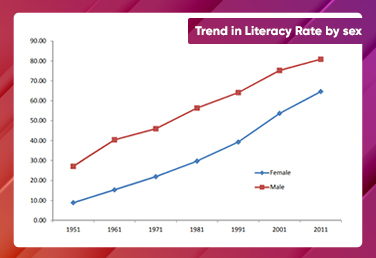
According to the statistics collated by the Ministry of Statistics and Program Implementation, the literacy rate in females shows an upward, increasing trend which has been all the more effective since the 1990s.
The progress in female literacy is due to multiple factors like the policy and program initiatives to increase school enrolment and the focus on improving and retaining school enrolments. This improvement also indicates the government’s approach towards empowering women with quality education and the encouragement given to the girl child to pursue her education.
- Sex ratio: According to the Ministry of Statistics and Program Implementation (MOSPI), the sex ratio increased in 2001 and 2011, when there were 933 females per 1000 males and 943 females per 1000 males, respectively. The Ministry of Statistics and Program Implementation’s report on Women and Men in India 2020 projects the sex ratio at 948 females per 1000 males in 2021.
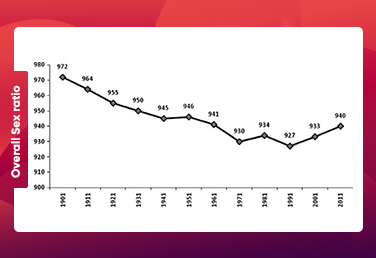
The graph on the Sex Ratio trend shows an increase since 1991. The ascent could be attributed to the awareness and the policies that the government introduced around the same time, along with improvements in the female literacy rate, resulting in a reduction of gender bias.
The government’s efforts in skilling, upskilling and reskilling the female population has resulted in newer job opportunities for women in the manufacturing and services sector. The defence sector, believed to be an unconventional sector for women, has seen a significant increase in women’s employment.

According to the Periodic Labour Force Survey 2018-2019, the female labour force has a combined higher average of 18.6% in 2018-19, against 17.5% in 2017-18. The female labour force participation rate indicates the number of females employed in the country.
The evolution of the role of women in today’s world is phenomenal, compared to how it was in the early years. Women today have taken up multiple roles in society, from President, Prime Minister to pioneers in numerous fields. When it comes to the education space, they are performing better than their counterparts. Women have now become independent and are earning members of the family.
The future for women and girls seems bright, with society and the government encouraging them to realise their true potential and conquer every field out there. This is just the beginning of a beautiful journey! Encouraging and empowering the girl child is a continuous process. It is now in our hands to ensure every girl child gets a quality education and other amenities for an even better future!


